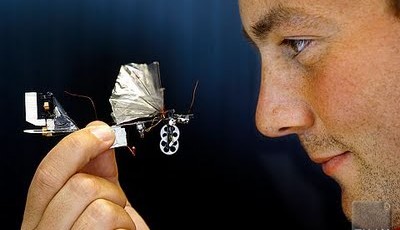DelFly, the Autonomous Robot Dragonfly
on

Technical University (TU) Delft (Netherlands) researchers have developed the DelFly Explorer, the world's first Micro Air Vehicle with flapping wings that can avoid obstacles by itself. The uniqueness of this achievement lies in the DelFly Explorer's very low weight (20 grams, i.e. a few sheets of paper), and this opens up new possible applications for both smaller and larger MAVs.
With its two flapping, transparent wings, the DelFly most closely resembles a robotic dragonfly. The micro aircraft has now been fitted with a new system of binocular vision. The vision system weighs only four grams and consists of two cameras and a tiny computer. By combining the images of both cameras, the distances to obstacles are determined in the same way as in humans with two eyes. The tiny computer processes the images as soon as they are received so that the DelFly knows precisely where obstacles are located.
If an obstacle is detected, the DelFly will continue to fly a small distance ahead before flying in a circular motion until the obstacle is no longer visible; it then continues its journey in this direction. In this way, the micro aircraft is able to explore unknown spaces independently, without outside assistance.
The DelFly Explorer can perform an autonomous take-off, maintain its height, and avoid obstacles for as long as its battery lasts (~9 minutes). All sensing and processing is performed on board, so no human or offboard computer needs to be in the loop.
There are other MAVs that can also avoid obstacles, such as quad rotors, but these weigh 50 times as much or more. The challenge for the TU Delft researchers was therefore to make this system light and fast enough for the DelFly to be able to use it. The system also had to be adapted to accommodate the flapping movement of the wings. A specially developed algorithm enables the DelFly to process the images just as quickly as they are received.
The DelFly can be deployed in a variety of ways, for example to detect ripe fruit in greenhouses, to stream live video of parties or concerts from above, or even as an autonomous flying fairy in a theme park.
The developed stereo vision system will be valuable for larger MAVs as well. It can contribute to their obstacle avoidance capabilities, while hardly affecting their payload capability.
Source: Phys.org


Discussion (0 comments)